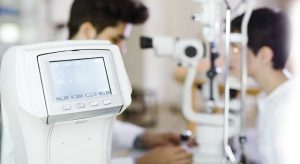Over 75% of people who work on computers suffer from computer eye strain, especially those over the age of 40.
Sunlight is made up of a variety of colors – red, orange, yellow green, blue, indigo and violet light. When combined, they create white light. Each of these colors represents a different light wavelength.
The higher the energy, the shorter the wavelength. The shortest wavelengths on the visible light spectrum are blue and violet, which are just below the ultra-violet wavelengths in terms of energy output.
The visible spectrum’s high-energy end is commonly referred to as blue light. When we stare at the screen of our digital devices, we are exposed to this high energy visible (HEV) blue light.
Long-term exposure to HEV can cause eye strain.
Sources of HEV light
The largest source of HEV and blue light is the sun, other sources include:
- LED light
- Fluorescent light
- Flat screen LED televisions
- CFL (Compact Fluorescent Light) bulbs
- Computer monitors, tablet screens, and smartphones
Is HEV light always bad for your eyes?
No. Blue light exposure is beneficial because it aids in the regulation of sleep and the prevention of depression and Seasonal Affective Disorder (SAD). Going outside during the day and spending time in the sunlight is a great way to receive beneficial levels of blue light.
The problem with HEV/blue light is when it arrives from our digital devices.
When we use a digital device our eyes are being exposed to concentrated and constant blue light in a way that we do not see in nature.
Contact an eye doctor near you, to make sure you are protecting your eyes from HEV/blue light.
SEE RELATED: Blue Light and Screens
How does blue light cause digital eye strain?
Our eyes absorb all kinds of light, including high energy light. This light enters the retina straight through the cornea and lens.
Blue light from digital devices and computer screens can reduce contrast, causing digital eye strain. Dry eyes, fatigue, bad lighting, and the way you sit in front of your computer can also contribute to eye strain. Typically, you will feel soreness, discomfort and perhaps blurred vision.
HEV and other eye problems
Scientists are investigating whether there is a link between blue light may put your eyes at risk of:
Macular degeneration
For people over the age of 60, macular degeneration (AMD) is the major cause of vision loss. According to the Schepens Eye Institute, a poor density of macular pigment may be a risk factor for AMD since it allows for more blue light damage.
Cataracts
According to recent studies published by International Journal of Ophthalmology (2018), there is a clear correlation between blue light exposure and the development of cataracts. What’s more alarming is that there’s very little information on long-term exposure.
Protect your eyes from blue light
Nowadays, most of us spend a significant amount of time in front of a TV, computer screen, tablet, or smartphone.
Here are some ways to lower your exposure to blue light and minimize eye strain:
- Add warm lighting to your home and office to have a lower proportion of blue light
- Limit screen time on your smartphone, tablet, laptop or computer.
- Take frequent breaks from digital devices. To ease eye strain, every 20 minutes, take a 20-second break and look at something 20 feet away
- Glasses with blue-light blocking lenses
LEARN MORE: Guide to Eye Exams
Schedule an appointment with an eye doctor near you who can provide advice on how to minimize eye strain from HEV/blue light exposure.
If you experience eye strain whilst using a computer, there are many solutions that you can discuss with your eye doctor.


